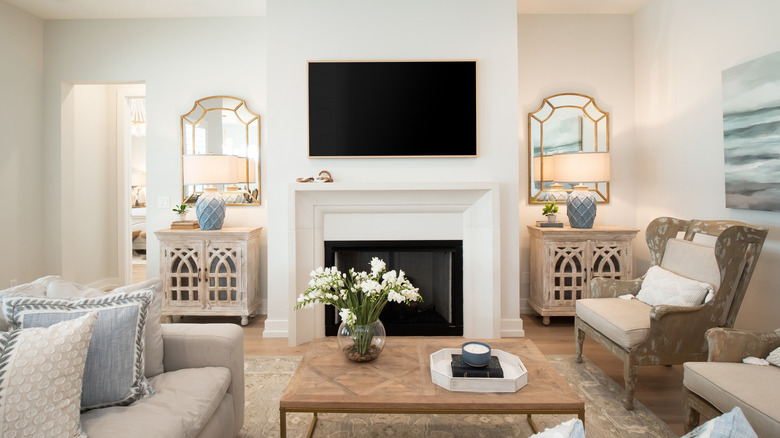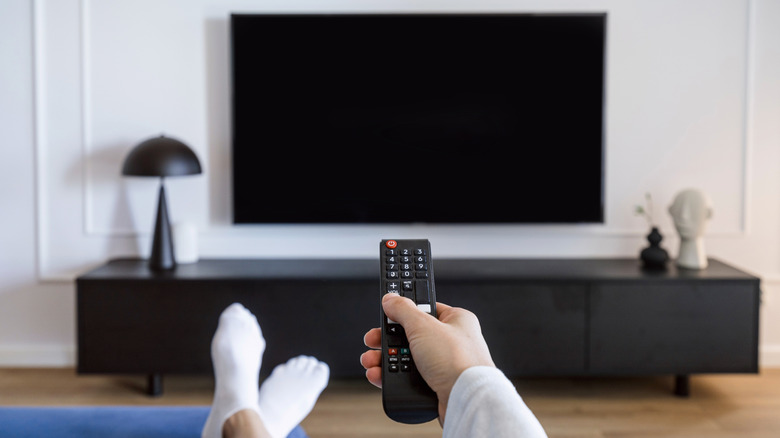Why Hanging Your TV Above Your Fireplace Is A Huge Mistake (And Alternatives To Try)
We may receive a commission on purchases made from links.
As cozy as it may seem to curl up in front of a fire while watching your favorite shows, you may want to think again before mounting that new TV over your fireplace. If you're trying to integrate your TV into your living room, that location is not recommended, thanks to how it can affect your viewing experience and electronics' functioning.
Though you might like the look of a TV over a fireplace, it's not a comfortable viewing location in the long term. The ideal height to mount your TV to get the perfect view is whatever places the center of the screen level with your eyes when seated, approximately 42 to 48 inches from the floor. The average fireplace mantle is around 52 to 56 inches high — that all but guarantees you'll be viewing at an angle that requires craning your neck, which can lead to chronic headaches if it happens often enough. Improper screen height can also cause neck pain, stiffness, and eye strain.
On top of the physical strain, having to look up at your TV will also affect the quality of the picture you're seeing. The majority of TVs on the market are LCDs, which work by letting light pass through a matrix of small shuttered windows. The picture on your screen only looks its best when you view these windows from right in the middle, both horizontally and vertically. Looking up at a TV above a fireplace can cause images to look lower contrast and more washed-out.
Fireplaces can damage your TV
Placing your TV above a fireplace isn't just painful for your eyes and neck — if the fireplace is functional and not just for decoration, it can also damage the TV itself. The heat coming from the fireplace can cause electrical resistance to deteriorate, which lets more electric current flow through than wires can handle and causes damage. Electronics like laptops have internal fans to help with this, but TVs typically don't, so they're extra susceptible to heat damage. Even when the power is off, the temperature fluctuations caused by being near an intermittent heat source can damage a TV's internal elements by making them expand and contract.
That's not even accounting for the ways smoke and soot from a wood-burning fireplace can wreak havoc on electronics. If your fireplace creates soot, that dirt and grime can get inside the nearby TV and cause parts to fail eventually. Smoke acts similarly, creating a buildup of film that makes your electronics run hotter than they should. The resulting damage happens over time, so chances are decent that your warranty will be expired by the time your TV goes kaput entirely. To make matters worse, many warranties are voided by exposing your TV to extreme heat, so you might not get repairs covered for any type of damage.
What's a better place to mount your TV?
When deciding where else to mount your flat-screen TV, height is one of the most important factors — remember, you're aiming to keep the center of the screen in the center of your vision. If it can't be centered for some reason, placement that's a little too low will give you less eye strain than placement that's a little too high. Make sure you're mounting the TV somewhere close enough to a power source for it to function.
As for which wall is best for putting up your TV, avoid walls across from windows, particularly west-facing windows, to cut down on glare. If you want to keep all the focal points of your living room on one wall, consider mounting the TV off to the side of the fireplace, as long as it's out of the heat danger zone. You might also consider not mounting your TV at all and instead opting for a stand; if space is an issue, you can even maximize your living room space with a corner TV stand.
If you're dead set on installing a TV above your fireplace, you can redirect some of the heat by installing a mantel or built-in blowers. Be aware that if the temperature of your planned mounting spot measures over 100 degrees Fahrenheit after an hour of the fireplace staying lit, it's still not a safe TV location. To solve viewing angle issues, try a mount that tilts your TV, like the Sanus VMPL50A-B1.


